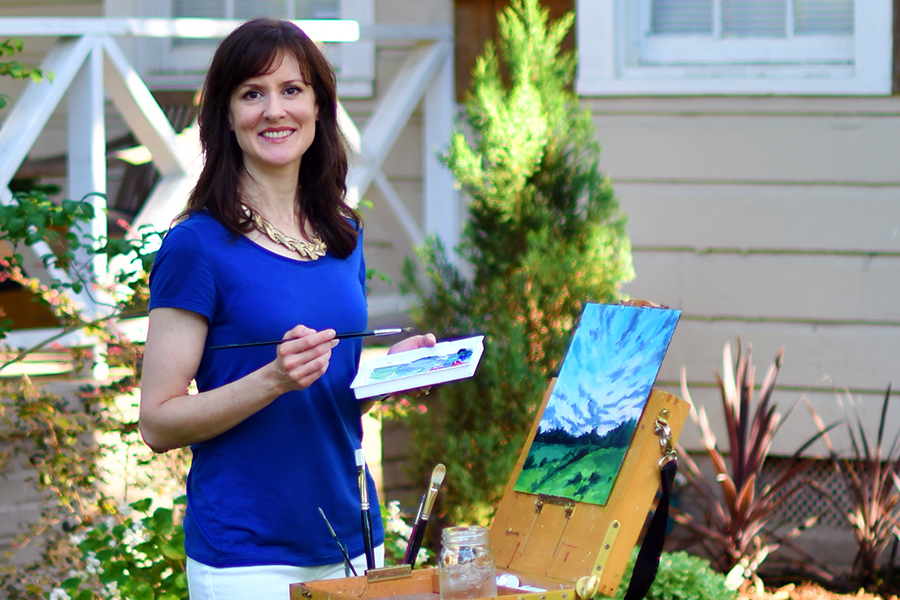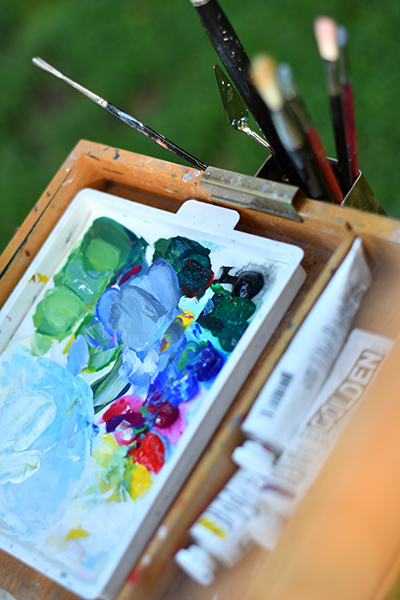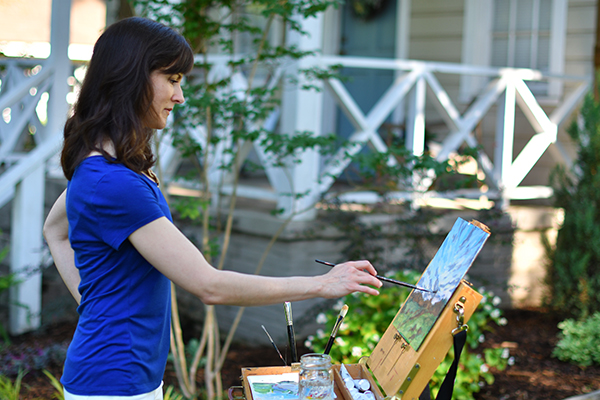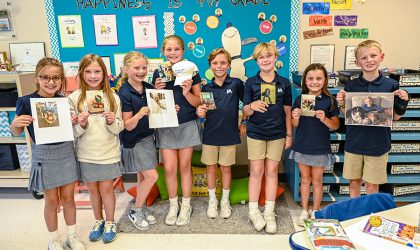

Joy Miller teaches visual art, but during her time at Jackson Academy, she has taught so much more. Step into one of her classrooms (she has two), and you will find an inspiring space full of student creativity in every medium. Most importantly, you will find students enjoying the process of artistic discovery under Miller’s guidance.
Miller joined JA’s faculty in 2018 as the Middle School art instructor and has also taught second through fourth grade since the fall of 2019. Originally from Massachusetts, Miller attended Anna Maria College and earned a bachelor’s degree in visual art education, but she has studied and created art since she was a young girl. During her senior year of college and after graduation, Miller worked as a substitute teacher for two school systems in Massachusetts before moving to Mississippi, where she taught art for six years before coming to JA.
We sat down to pick Miller’s brain about the benefits and challenges of visual art education. Check out an excerpt from her answers below and visit the JA website to read the full conversation.
Why do you think it is valuable for visual art to be included in a student’s education?
“We are all born creative beings, so to educate the whole child, we must provide space for developing and expressing that creativity. Going to art class gives students a chance to take a break from working in the left/logical side of their brain and enter a slower, more reflective kind of learning. Art provides the opportunity to develop manual dexterity, grit and perseverance, and creative problem solving – all skills useful in so many careers. I’m teaching future doctors, scientists, journalists, parents, artisans, lawyers, and teachers.”
What led you to your career in art?

“My parents always encouraged me as an artist, providing supplies and lessons whenever possible. I fondly remember my fascination with blank books and copy paper; the more the better. I was constantly illustrating stories, designing paper dolls, and crafting gifts from recycled “trash” for my family and friends. It wasn’t until I was in my late teens, however, that I seriously considered pursuing art. I discovered a love for painting outdoors, which led to a brief time of study with plein art painters David Lussier and Pamela Simpson-Lussier. Convinced that art would always be a big part of my life, I began attending Anna Maria College in Paxton, MA as a Studio Art major, soon turned Art Education major.”
Why did you decide to become a teacher?
“Initially, it was purely pragmatic; it made sense to pursue a profession with licensure and a clear career path. But soon it became obvious that I love working in a classroom environment and investing in children more than I love painting by myself in a studio. I appreciate the enthusiasm children have for making art, and to share in and even encourage that enthusiasm is such a privilege.”
If you were not teaching art, what would you be doing?
“When the school day ends, you’d probably find me working out at the gym, walking through the neighborhood with my husband, painting at my easel, or just taking care of things at home. I’m a real homebody. I just love being in my home.
“I’m a certified group fitness instructor, so if I had to choose an alternate career, I’d probably pursue a Pilates certification so I could teach Pilates in a studio setting. Maybe I’d even eventually teach kickboxing.”
What is your teaching philosophy?
“Everyone can learn and enjoy art. I strongly believe art is something that should be enjoyed. My heart breaks when adults share their negative experiences with art during their elementary school years and how they now can’t see themselves as an artist: they “can’t even draw a straight line!” To me, art is so much more than drawing lines, straight or not. Yes, I teach skills and technique. Yes, I hold my students to certain requirements based on my objectives for any particular lesson. I believe they’re capable of excellence and I do what I can to guide them there. But art is more than being able to draw. More than creating a masterpiece to frame and hang on the wall. It’s an experience. And I try to make it a positive one. I don’t want my students to grow up to be adults who hate art.
“Part of making art a positive in children’s lives is helping them personally connect with some part of it. So I expose my students to as many art media and techniques as possible. We work with clay, watercolor, printmaking, acrylics, scratchboard, weaving, ink, colored pencil, and so many more exciting materials. Not every student loves every medium. Like I tell them, it’s okay if you don’t like this particular medium or this particular project. But I hope that they’ll really connect with at least one medium and that it will develop their confidence and passion as an artist. Last year when I introduced clay to my students, one student got his hands on the clay and contentedly told me, “I know I’m not good at drawing [I had never told him that!], but clay…this is my thing.” Or consider all the fifth-grade boys who, once we started weaving, exclaimed that this was the best thing ever and wanted to weave for every class after that. All my students deserve that experience of discovering something that awakens the creativity inside them.”
If one doesn’t have artistic ability/experience what is the first thing you teach them?
“First off, I teach that art is something that can be learned. No one expects to go to math class knowing everything there is to know about math. They go because they know they need to learn. But frequently people think they already need to be “good at art” to be successful in art class. I tell them that I’m there to teach them because I don’t expect them to know everything and I don’t care if they’re not “good at art.” We’re there to learn together. We’re all born creative, but we aren’t all born knowing how to draw or which colors mix together to make that perfect green. Those are things that can be taught and learned.
“Practically, one of the first things I’ll teach a new artist is the importance of slowing down and really seeing. Our eyes are just as important as our hands in art. Only when we slow down and observe can we start to recognize relationships of shape and color and line and shadow in the world around us. That’s what’s going to help us learn how to draw, and that’s what’s going to fuel us with inspiration for what we actually create.”
What is your favorite part of the day with your students?
“I think my favorite part of each day would have to be once the kids have started making their artwork and I get to walk around and watch their creations coming to life. I offer instructions and have some idea of what skills a project will develop, but I never really know what my students are going to do with it. To see them take my instructions and create something new and beautiful is thrilling. I especially love when my students are really connecting with their artwork or when they are struggling but then work through an issue. Watching that process makes me so proud of them.”
What’s the biggest challenge you’ve faced while teaching?
“The biggest challenge, as a “special subject” teacher who teaches for two departments, with several hundred students spread out over four different hallways, is to connect with other faculty members and feel like I know what’s going on with my students in their other classes. But it’s also an incredible blessing to get to be part of so many students’ lives and watch them develop artistically from year to year.”
What is an accomplishment or project that was most successful for your career?
“This isn’t really an accomplishment, but one of the things that I believe most helped my career was my work as a substitute teacher. During my senior year of college and first year after graduation, I worked as a day-to-day and long-term sub for the Auburn and Worcester, MA school systems. Going to dozens of schools, observing faculty and administration, adapting to each new situation, and working in the classrooms of a variety of art teachers all prepared me for being the teacher I am now. It was tough, but even then I recognized the value of being exposed to so much diversity in such a short time. I learned firsthand what I did and didn’t like and what worked or didn’t work across schools.”
How do you motivate your students?
“I try to plan lessons that engage students right off the bat. I use a lot of direct instruction to teach skills and techniques, convey my objectives, and provide helpful parameters. I find that kids create much more thoughtful, well-developed work when they are given some guidelines and restrictions. With those parameters in place, I try to allow room for students’ personal choice and expression. The older the students, the more open-ended the projects tend to be. If students seem unmotivated, I’ll sometimes throw in a group project or discussion to keep the momentum going. And not infrequently I will adjust my curriculum plans when I notice a class’s interest in a particular theme or media.
“I constantly walk around my room as my students are working. I like to offer directional feedback, and most of it is positive. I just love being able to point out and celebrate something awesome that’s happening in a student’s piece. It can be as simple as the way they applied a brushstroke or the colors they chose to place side by side or the way they captured the spirit of their subject matter. I’d like to think that my genuine enthusiasm helps motivate my students.”
What’s the biggest lesson your students have taught you?
“My students have taught me that we’re all learning together. I love it when they know more than I do about something art-related and can share their expertise with the class. Their artistic thoughts and discoveries are a huge part of how the whole class learns and grows. I get so many good ideas from their observations and their artwork, and their feedback allows me to keep evolving as a teacher.”
What’s one thing/talent that few people know you have/do?
“I’ve always wanted to try kickboxing, so I picked that up within the past year and am obsessed. It is definitely my biggest non-art hobby.”
What or who inspires you and your art?
“My husband Colin is not only my number one fan who gives me confidence as both an artist and a teacher, but he also inspires me to be more curious. He’s always researching new ideas, building cool Lego creations, listening to wild sci-fi stories, and challenging me through philosophical or brain-bending conversations. I’m actually not a naturally curious person, so he prompts me to step outside the box and look at things in a new way.

“As far as artists who have inspired my artistic journey, Wolf Kahn would be at the top, along with many of the Impressionists, Mark Rothko, and my college professor Sumiyo Toribe. I was heartbroken to learn that Wolf Kahn passed away earlier this year. His colorful landscapes, simultaneously shocking and calming, have always spoken to me, but even more so, his steadiness and dedication to his life’s work — painting into his nineties — inspired the hope that I’d be as fruitful in my own career.
“Much of my personal artwork has been inspired by the natural world. I grew up in Massachusetts, and the New England landscape really deserves credit for making me an artist. I miss the cooler light, the crisp air, the wild shorelines, and the hills that move from green to blue to purple. My parents bought me a Holbein watercolor travel set and I would take that everywhere with me, stealing a few moments on family outings to capture everything I saw. That love for the landscape has stayed with me, although it has shifted and looked different over the years.”
Who inspired you growing up?
“All throughout my growing up years, there were always one or two women who really supported me and my art. They would admire and share my work. Purchase it and hang it on their walls. The same with my parents. They went out of their way to make sure everyone appreciated my little homemade greeting cards as much as they did! They all really believed in me. I think having adults invest in me when I was young has made me want to do the same for others. I want to be that kind, thoughtful, more-experienced and well-resourced adult for my students. I want them to know that I care about them and believe in them and will do whatever I can to help them succeed.
“Two other really huge influences came during my college years. I was privileged to work with two of art education’s very finest – Nancy Stangle and Kathleen Ivanowski. I completed my student teaching under Nancy at a large regional high school my junior year. There were eight or nine different teachers in that visual art department, but Nancy was the perfect placement for me. As I observed her over the weeks I realized she was very much who I could see myself becoming thirty years down the road. She was calm, settled, confident in her amazing skills as a teacher, but just so warm and motherly. I wanted to bring that same warmth and competency to my classroom one day.
“My first year out of college I was hired by Kathleen Ivanowski, then visual arts liaison for the Worcester Public Schools. Never before or since have I met someone who had such presence and influence, along with such genuine care and concern for the art teachers under her and all their students. When she talked with you, you felt like the most important person in the world. Kathleen’s belief in me gave me the confidence to persevere as a teacher. Ten years later and she’s still a close friend. If I could be a Nancy or a Kathleen for even just some of my students, I’d consider myself successful.”


